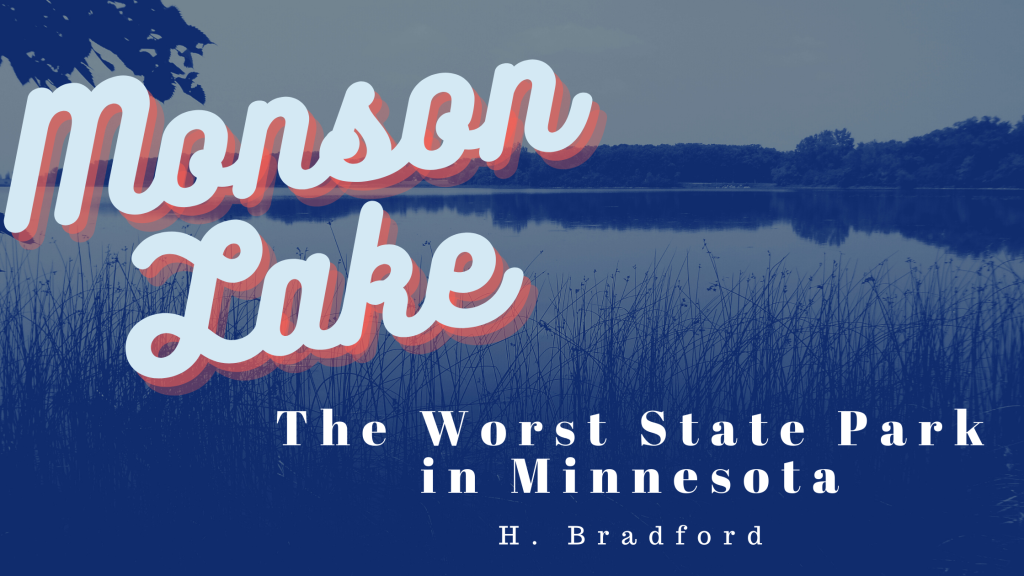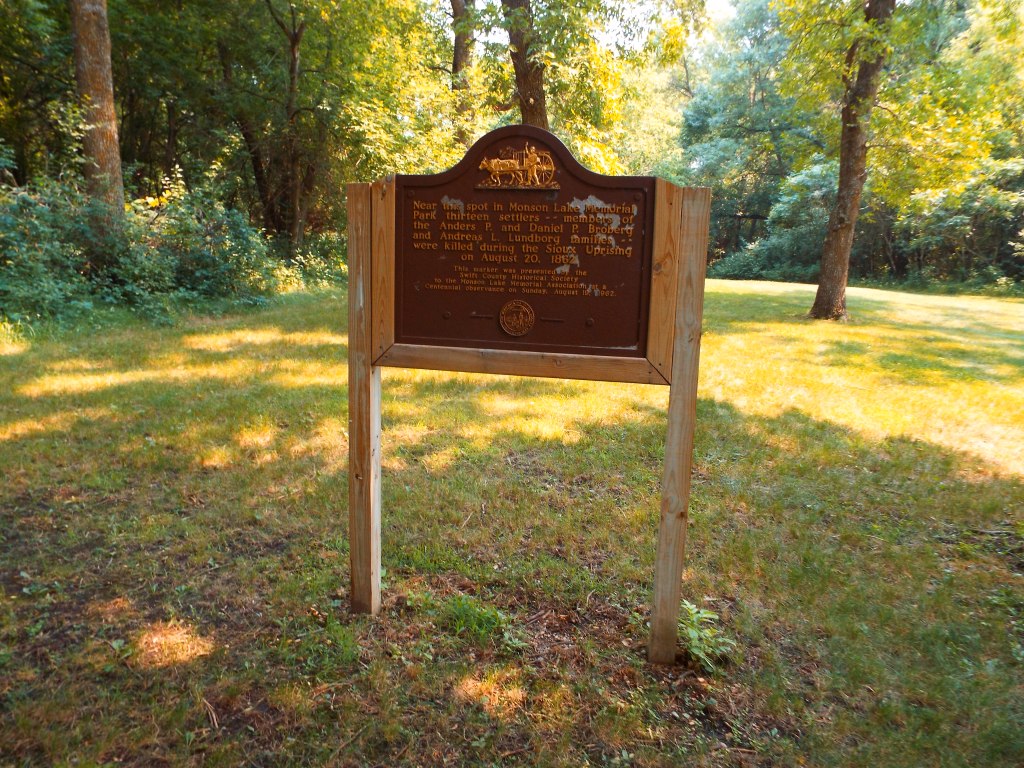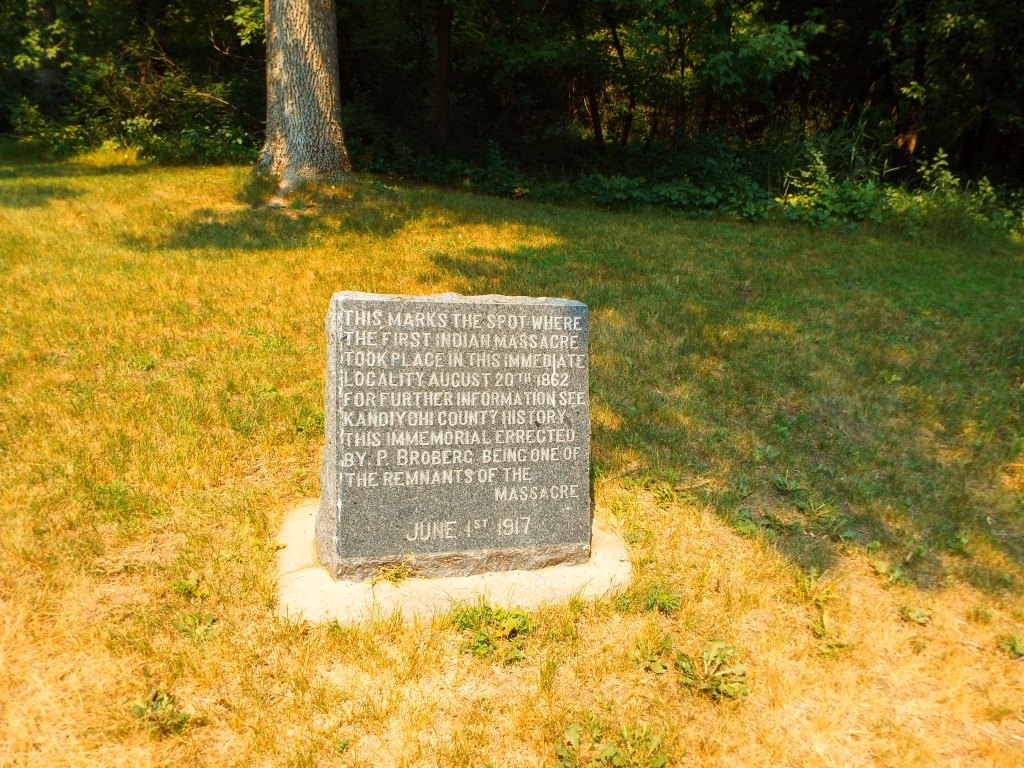Monson Lake: The Worst State Park in Minnesota
H. Bradford
I am on a slow quest to see every state park in Minnesota. To this end, I visited Sibley State Park with my brother this past weekend. While in the area, we decided to stop by Monson Lake since it was only 17 miles away. There are 75 state parks and recreation areas in the state, so of course, one of them is going to be the worst. Thus far, Monson Lake State Park is the worst on account of its history and size.
The history of why it was established is the worst aspect of the park. Monson Lake State Park was established in the 1920s as a private memorial park to remember the deaths of 13 Swedish settlers who were killed in the Dakota War of 1862. Since the park is small, this history of the park isn’t masked by size, a large network of trails, or other facilities. There is only one trail, a camp site, the lake, and some signs about the white casualties in the Dakota War. The few signs remain stilted towards colonial history. Although there is brief mention that the conflict arose out of the starvation conditions imposed upon the Dakota people on account of late annuity payments, the signs were more sympathetic to the history of settlers. For instance, the informational sign mentioned that the Dakota people were resisting white civilization, which is loaded language which attributes “civilization” to white people, but not to Native Americans. A more accurate word for what they were resisting was genocide. The sign denotes the names and ages of the colonists who were killed, whereas the impact of the conflict on Dakota people is unspoken and far more horrific. If the park remains, it should expand its signs to include more information about Native American history of the region, more information about the conflict, and also facts about what happened after the Dakota War of 1862. The outcome of the Dakota uprising was the largest mass hanging in U.S. history (when 38 Dakota prisoners were hanged in a single day in Mankato) and mass internment. 1,600 Dakota prisoners of all ages were held near Fort Snelling, of which 300 died that winter. Previous treaties were nullified and the Dakota were forcibly expelled from Minnesota, with a bounty on any found in the state and state sponsored scouting parties to scalp those who remained.
There are several other state parks which have connections to the Dakota War of 1862. Nearby Sibley State Park was named after Henry Hastings Sibley, the first governor of Minnesota and a commander in the Dakota War. The park itself was established by a survivor of the Dakota war who wanted to see a local park established in the area. Fort Ridgely State Park was also established as a memorial to its role in the conflict. This park features a fort defenders monument and the site served as a fort in the war. As mentioned, Fort Snelling State Park was the site of an internment camp after the war. Lake Shetek State Park was established from a site where settlers were buried after the war. Flandrau State Park was named after Charles Flandrau, a settler who defended New Ulm. Since many of these parks are in Southern and Western Minnesota, I have not yet visited them and it may happen that they are worse than Monson Lake. It remains to be seen how and if these parks approach this history. However, the sheer number of state parks with connections to the war should demonstrate that the state park system arose out of a movement to preserve and commemorate a certain version of history. It is easy to treat state parks as benign public spaces to preserve nature, but they are largely white spaces.
Aside from this history, Monson Lake is rather small. It doesn’t seem like a destination in its own right. At 343 acres, it is not the smallest Minnesota State park. However, it featured only one trail, which took less than an hour to explore. The campground and lake seem like they could be locally attractive, but might have been better as a municipal park. The office is not staffed, so visitors must go to nearby Sibley State Park for passes or to speak to a ranger. Again, because of its small size and lack of points of interest, the history seemed like the main attraction.
The park may have some good qualities. For instance, the lake might offer opportunities for birding. My brother and I saw three snakes within the first few minutes of the hike, so the park seems to punch above its weight in reptiles. We also saw chipmunks, toads, a dead turtle, egret, and several other birds. The park is a small area but seemed to have a large number of animals for its size. Again, it probably is a nice local place for a picnic, camping, or fishing, but hardly worth the drive for visitors outside the area. The fact that it is a state park means that it is a protected area, which preserves it from private development. This should be viewed as a plus. But, the history is uncomfortably colonial and this is something which needs to change. Thus, that is why it is the worst state park I have been to.





